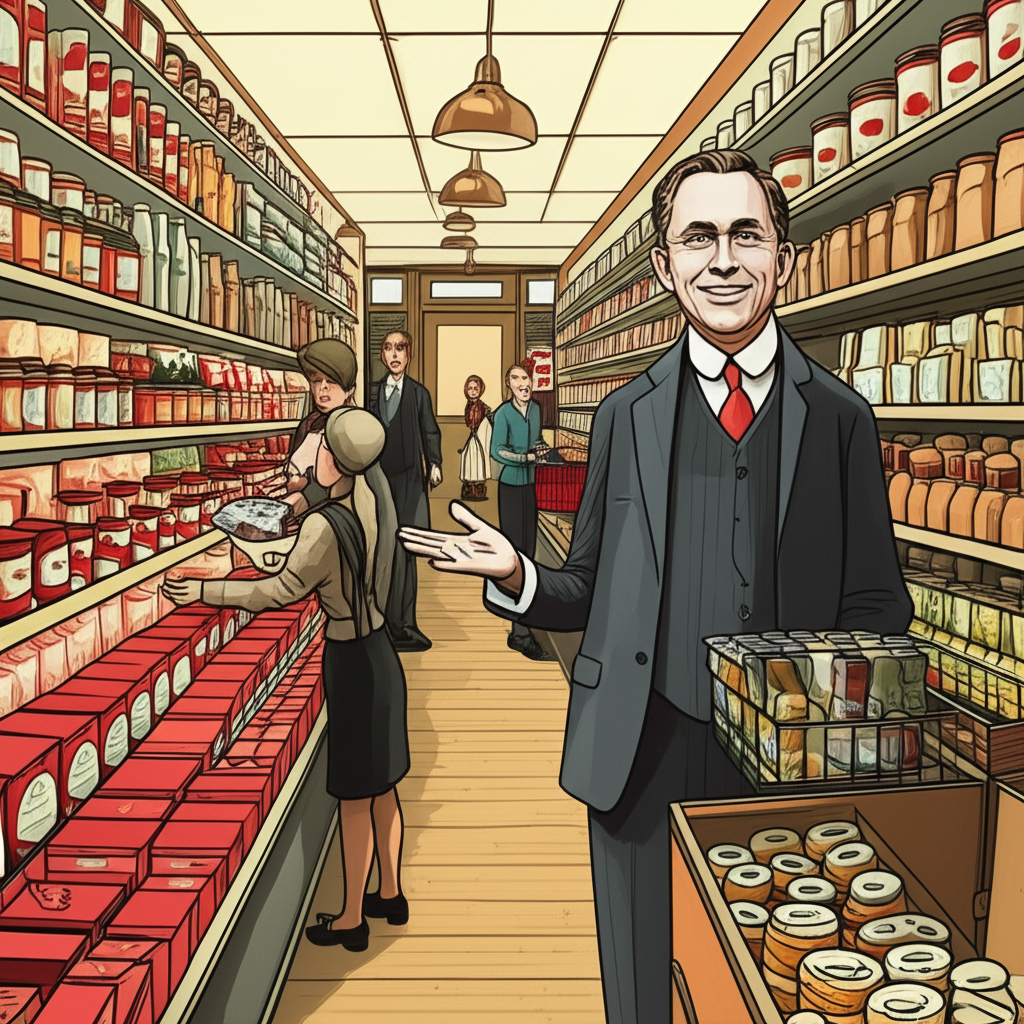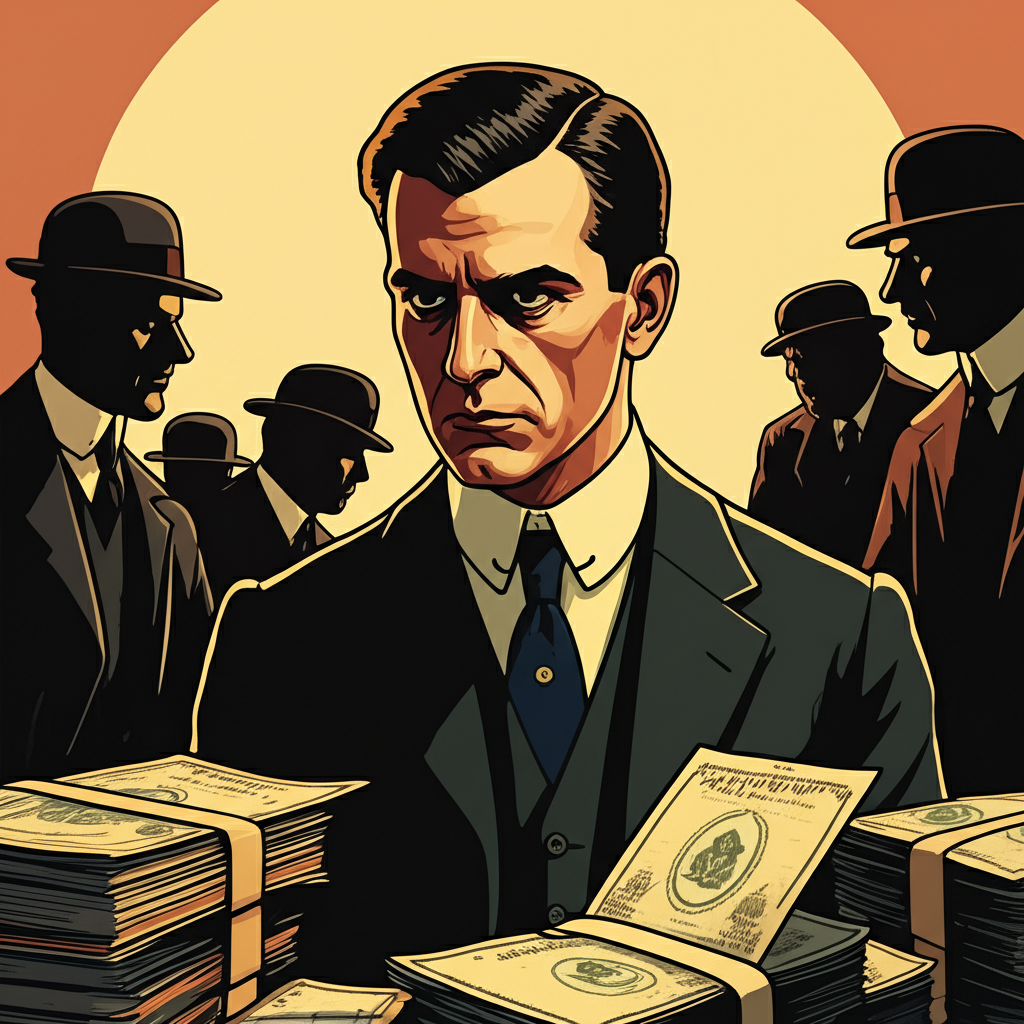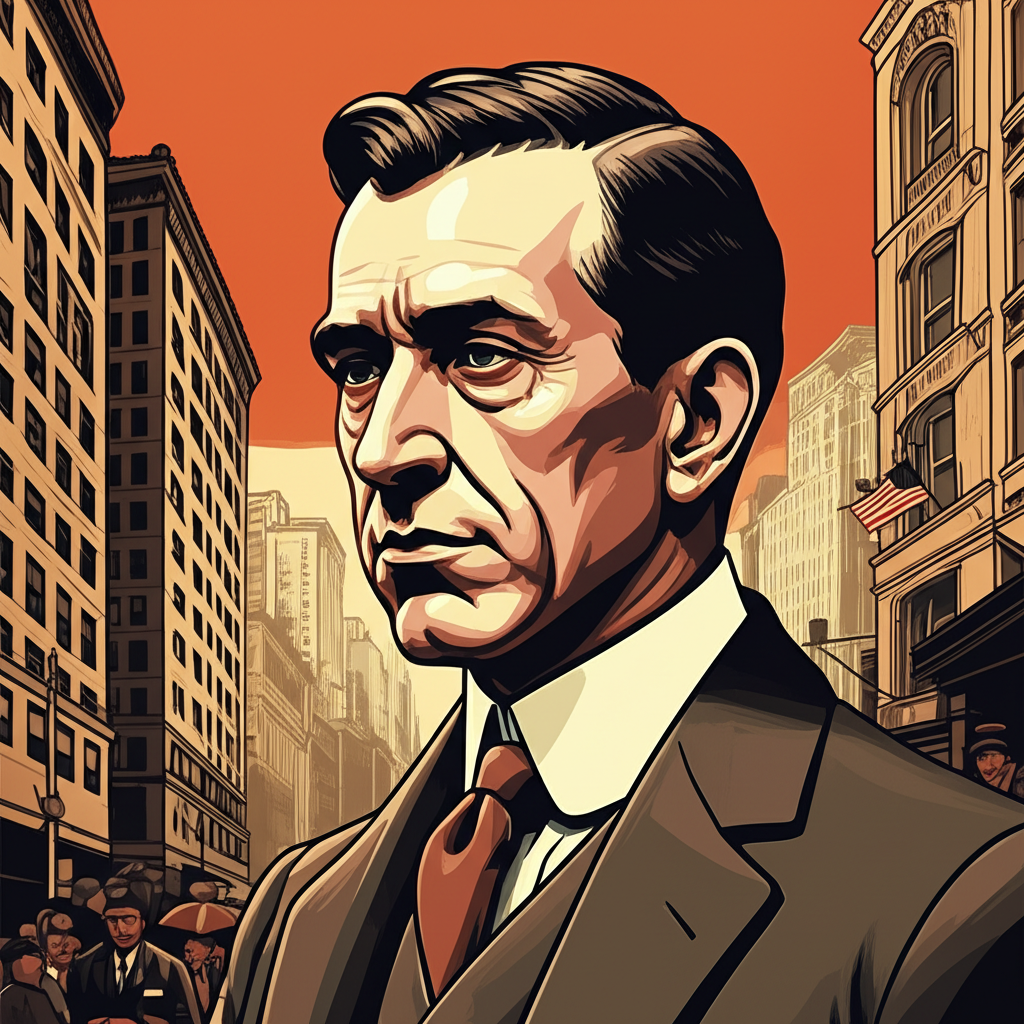Introduction: The Echo of 1922 – When Piggly Wiggly Cornered Wall Street

The financial world was stunned in early 2021 by the GameStop short squeeze—a digital uprising where retail investors banded together online to defy institutional investors and upend market expectations. Yet long before social media fueled financial rebellions, a lone entrepreneur in Memphis waged a similar battle using nothing but sheer will, financial cunning, and a network of brokers. In 1922, Clarence Saunders, founder of Piggly Wiggly, executed one of the boldest market maneuvers in American history: an attempt to corner the stock of his own company and force Wall Street short sellers into submission. This high-stakes drama unfolded during the Roaring Twenties, an era defined by economic exuberance, minimal regulation, and a growing fascination with stock speculation. Saunders’ clash with the New York Stock Exchange didn’t just shake the financial establishment—it exposed the raw mechanics of market power and set a precedent that still resonates today.
Clarence Saunders: The Visionary Entrepreneur Behind Piggly Wiggly

Clarence Saunders wasn’t just a grocer—he was a disruptor. Born in 1881 in Virginia, he entered a retail world where customers handed their shopping lists to clerks who fetched goods from behind counters, a system slow, expensive, and ripe for innovation. In 1916, Saunders opened the first Piggly Wiggly in Memphis, Tennessee, introducing a radical concept: the self-service grocery store. Shoppers could now walk the aisles, pick their own items, and pay at a centralized checkout counter. This model slashed labor costs, reduced prices, and transformed grocery shopping into a faster, more transparent experience.
The impact was immediate and far-reaching. Within a few years, Piggly Wiggly expanded into a national franchise with hundreds of locations across the U.S. Saunders didn’t stop at logistics; he introduced individual item pricing, standardized packaging, and even early versions of shopping baskets. His innovations became the blueprint for modern supermarkets. As the company grew, it went public, and Saunders retained a substantial ownership stake. But as Piggly Wiggly’s stock began attracting Wall Street attention, so too did it attract skepticism—and short sellers who believed the company’s rise was unsustainable.
The Audacious Plan: How Saunders Orchestrated the Piggly Wiggly Short Squeeze

Frustrated by what he saw as unwarranted attacks on his company’s value, Saunders decided to fight fire with fire. Rather than defend through corporate earnings or expansion, he launched a counteroffensive in the stock market itself. His strategy was simple in theory, audacious in execution: buy up as many outstanding shares of Piggly Wiggly as possible, leaving short sellers with nowhere to cover their positions.
Short sellers had borrowed shares, sold them at market price, and hoped to buy them back later at a lower cost. If the stock rose instead, they’d face mounting losses. Saunders aimed to make that rise inevitable—and catastrophic for his opponents. Beginning in late 1922, he leveraged personal assets and secured loans to begin a stealthy stock acquisition campaign. Through a network of trusted brokers, he purchased shares on the open market and directly from loyal shareholders. He even placed newspaper ads urging investors not to sell to “bear raiders,” positioning himself as the defender of the company’s true value.
Cornering the Market: The Strategy Unveiled
The plan reached its climax when Saunders and his syndicate gained control of approximately 195,000 of the 200,000 outstanding shares of Piggly Wiggly. With nearly the entire float locked up, short sellers found themselves in a classic squeeze: they were obligated to return borrowed shares, but there were almost none left to buy. As demand for the scarce remaining shares exploded, the stock price surged from its baseline of $40–$50 per share to over $100, peaking near $124.
The pressure was immense. Major Wall Street firms that had bet against Piggly Wiggly now faced potential ruin. Their only source of shares? Clarence Saunders himself. He held absolute leverage, able to dictate terms and extract massive premiums. For a brief moment, it appeared that a single entrepreneur had outmaneuvered the entire financial elite.
The Role of the NYSE and Wall Street’s Reaction
But Wall Street wasn’t about to concede. As losses mounted among powerful brokerage houses, they appealed to the New York Stock Exchange for relief. At the time, the NYSE operated with considerable discretion, unbound by the strict regulatory frameworks that would later emerge. On March 27, 1923, the exchange made a controversial decision: it declared a “postponement of delivery” for Piggly Wiggly shares. This unprecedented move effectively suspended the settlement deadline, giving short sellers extra time to locate shares and avoid being forced to buy at Saunders’ inflated prices.
The intervention shattered the squeeze. With the immediate deadline removed, the urgency evaporated. Short sellers could now acquire shares gradually, often at lower prices, while Saunders was left holding an enormous, illiquid block of stock. The exchange’s action, though framed as a move to preserve market stability, was widely seen as a bailout for the losing side—brokerages with deep institutional ties.
The Fallout: Victory, Defeat, and Lasting Consequences
While Saunders had technically succeeded in cornering the market, the NYSE’s intervention stripped him of the victory. He couldn’t force short sellers to pay peak prices, and the cost of financing his massive stock position became unsustainable. Burdened by debt and unable to liquidate his holdings without crashing the price, Saunders faced financial collapse. By 1923, he was forced to relinquish control of Piggly Wiggly and filed for personal bankruptcy.
The episode underscored a critical imbalance: even a flawless market strategy could be undone by the institutional power of exchanges and regulatory bodies. Yet, despite Saunders’ downfall, the company endured. The self-service model proved resilient, and Piggly Wiggly continued to thrive as a regional grocery powerhouse.
A Legacy Beyond the Squeeze: The Future of Piggly Wiggly
Far from disappearing after its founder’s financial ruin, Piggly Wiggly adapted and survived. The brand’s identity remained strong, rooted in the revolutionary retail principles Saunders had established. Independent franchisees kept the stores operational across the Southern and Midwestern United States, preserving a nostalgic yet functional shopping experience. In 2003, Southeastern Grocers acquired around 100 Piggly Wiggly Carolina Co. locations, demonstrating the brand’s lasting market relevance. The acquisition highlighted the ongoing vitality of the Piggly Wiggly brand, proving that a strong retail concept could outlive its creator’s financial missteps.
The 1920s Financial Landscape: A Unique Breeding Ground for Speculation
The Piggly Wiggly squeeze didn’t happen in a vacuum. The 1920s were a time of economic boom, mass consumerism, and speculative frenzy. The stock market, rising steadily after World War I, became a national pastime. Margin buying—purchasing stocks with borrowed money—was common, amplifying both gains and risks. There was no Securities and Exchange Commission; oversight was minimal, and enforcement of market rules relied heavily on informal agreements among brokers.
In this environment, aggressive tactics like market cornering were not only possible but occasionally successful. The NYSE acted more as a self-regulating club than a formal authority, wielding broad discretion to maintain order. Saunders’ campaign, while extreme, operated within the loose boundaries of the time. The lack of transparency and regulatory teeth created fertile ground for bold players willing to exploit systemic gaps.
Lessons Learned: Piggly Wiggly’s Enduring Relevance in Modern Markets
The Piggly Wiggly short squeeze remains a powerful case study in market dynamics. It illustrates the dangers of short selling when supply is constrained, the influence of leverage, and the critical role of regulatory intervention. More than that, it reveals the tension between individual actors and institutional power—a theme that echoes through financial history.
From 1922 to 2021: Piggly Wiggly and the GameStop Short Squeeze
The parallels between Saunders’ 1922 campaign and the 2021 GameStop event are impossible to ignore. Both involved heavily shorted stocks, dramatic price surges, and a clash between retail participants and institutional investors.
Similarities:
- High Short Interest: Both Piggly Wiggly and GameStop were prime targets due to elevated short interest.
- Coordinated Buying Pressure: Saunders acted alone but with the force of a collective. In 2021, Reddit’s r/wallstreetbets functioned as a decentralized army, coordinating buys through social media.
- Market Disruption: Both events caused significant losses for hedge funds and sparked debates about market fairness.
- Regulatory Response: In both cases, exchanges and regulators stepped in, raising questions about manipulation and market integrity.
Differences:
- Technology: GameStop’s surge was fueled by zero-commission trading apps and viral social media. Saunders relied on phone calls, telegrams, and newspaper ads.
- Regulatory Framework: The 1922 intervention was discretionary. In 2021, regulators operated under established SEC rules, though debates over their adequacy persisted.
- Participants: Saunders was a wealthy insider. GameStop’s movement was led by anonymous retail traders, many with limited capital.
- Outcomes: Saunders lost everything. GameStop investors saw mixed results—some profited, others lost, but no single figure faced total ruin.
As the Council on Foreign Relations noted in its analysis of the GameStop phenomenon, “the GameStop saga illustrates how new technologies and a new generation of investors can challenge established market norms.” That same spirit of defiance was embodied by Saunders a century earlier.
Conclusion: A Timeless Tale of Market Power and Innovation
The Piggly Wiggly short squeeze of 1922 is more than a financial curiosity—it’s a landmark moment in the evolution of market behavior. Clarence Saunders was both a retail pioneer and a market tactician, whose ambition outpaced even his own success. Though he lost control of his company and his fortune, his legacy endures in every self-service supermarket and in every discussion about market fairness.
The event highlighted vulnerabilities in the financial system, contributing to later calls for stronger regulation. It also demonstrated that innovation isn’t confined to products or services—it can extend to how markets themselves are navigated. From the manual trading floors of the 1920s to today’s algorithm-driven exchanges, the forces of supply and demand, fear and greed, remain unchanged. The Piggly Wiggly saga reminds us that while tools and rules evolve, the human element—the drive to challenge, to win, to disrupt—endures.
Frequently Asked Questions (FAQ)
What was the actual stock price movement of Piggly Wiggly shares during the 1922 short squeeze?
Before the squeeze commenced, Piggly Wiggly shares were generally trading in the range of $40 to $50. As Clarence Saunders accumulated shares and trapped the short sellers, the price began to climb dramatically. It reportedly surged to over $100 per share, reaching a peak of around $124 per share at one point, before the NYSE’s intervention deflated the squeeze and caused the price to fall back.
Who were the main financial institutions or brokers that were short Piggly Wiggly stock in 1922?
While specific names of all involved institutions are not widely publicized, it is understood that several prominent Wall Street brokerage houses and institutional investors were caught on the short side of the trade. These were typically the “bears” Saunders referred to, who believed Piggly Wiggly’s stock was overvalued and bet on its decline. Their collective position was significant enough to prompt the NYSE’s intervention when they faced potential ruin.
How did the rules of the New York Stock Exchange in 1922 differ from today’s, impacting the Piggly Wiggly squeeze?
In 1922, the NYSE operated with far fewer formal regulations compared to today. There was no Securities and Exchange Commission (SEC), and anti-manipulation rules were less defined. The exchange had significant discretionary power to intervene in market activities it deemed disruptive, often acting based on informal agreements among members. This allowed the NYSE to make an unprecedented ruling by postponing the delivery date for Piggly Wiggly shares, effectively breaking Saunders’ squeeze, a move that would be highly controversial and potentially illegal under today’s codified regulations.
Beyond the squeeze, what were Clarence Saunders’ major innovations in the grocery retail industry?
Clarence Saunders revolutionized grocery retail by introducing the self-service model. His innovations included:
- Customers selecting their own goods from open shelves.
- Checkout stands with cashiers.
- Individual item pricing.
- Shopping carts (though he didn’t invent them, he popularized the concept).
- A focus on reducing overhead to offer lower prices.
These concepts became the industry standard and are still fundamental to modern supermarkets.
Was there any legal action or criminal charges filed against Clarence Saunders or others involved in the Piggly Wiggly short squeeze?
While the NYSE intervened and Saunders faced financial ruin, there were no known legal actions or criminal charges filed against him for “market manipulation” as a result of the short squeeze. At the time, the legal framework for market manipulation was less developed, and the NYSE’s primary role was to maintain order and mediate disputes among its members. Saunders’ actions, while aggressive, were largely seen as within the bounds of what was permissible, albeit disruptive, in the unregulated market of the 1920s.
How did the media of the 1920s cover the Piggly Wiggly short squeeze, and what was public perception like?
The Piggly Wiggly short squeeze garnered significant media attention in the 1920s, featuring prominently in financial newspapers like The Wall Street Journal and major dailies. Saunders was often portrayed as a maverick entrepreneur challenging the Wall Street establishment. Public perception was mixed; some admired his audacity and seen him as a populist hero taking on the “big guys,” while others viewed his actions as reckless speculation. The dramatic nature of the event, with its high stakes and colorful characters, made it a captivating story for the public.
What financial lessons from the Piggly Wiggly short squeeze are still applicable to individual investors today?
Key financial lessons include:
- Risk of Short Selling: It highlights the unlimited risk associated with short positions if a stock’s price rises unexpectedly.
- Market Power: Even in modern markets, concentrated buying can influence prices, though outright cornering is much harder.
- Regulatory Influence: Be aware that exchanges and regulators can intervene, sometimes altering market dynamics.
- Leverage Risks: Saunders’ over-leveraging ultimately led to his downfall, a timeless warning about borrowing too much to invest.
Could a similar “cornering the market” short squeeze happen in today’s highly regulated and technologically advanced stock markets?
An outright “cornering” of a widely traded stock, as Saunders achieved, is highly unlikely today. Modern markets are far more regulated, with the SEC overseeing anti-manipulation rules. Market surveillance is sophisticated, and liquidity is generally much higher, making it nearly impossible for a single entity to acquire all available shares of a public company. Additionally, rules regarding short selling, reporting, and delivery are much stricter. While short squeezes can still occur (as with GameStop), they are typically driven by a sudden surge in demand rather than a single entity literally owning all available shares, and regulators are quick to investigate any signs of artificial manipulation.

留言